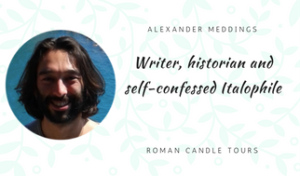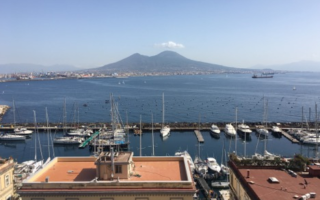The Unknown Leonardo Da Vinci
 |
| Photo credit: Smithsonian Journeys |
Of the venerated titans of Florence’s cultural Renaissance, none left quite the same mark as Leonardo Da Vinci (1452 – 1519). The polymath, artist, and inventor was, in the words of his biographer Giorgio Vasari, blessed with “a beauty of person never sufficiently admired” and invested with a “wonderful grace in all his actions.”
Even without the testimony found in Vasari’s Lives of the Artists, the great master’s genius would be clear for all to see. Such was his strength of intellect that whatever he turned his mind to he made himself master of with ease. Little wonder then, that Leonardo has left the world a legacy that is as monumentally impressive as it is mind-bogglingly vast.
 |
| Photo credit: Smithsonian Magazine |
Among the prototypical Renaissance man’s catalogue of compositions, we can count the Mona Lisa, its subject smiling demurely (or perhaps aloofly) at six million visitors to the Louvre each year. We have the Last Supper, the most famous mural in Milan — if not the world — depicting the dramatic moment Christ revealed his imminent betrayal.
 |
| Photo credit: WikiArt |
Then we have the iconic Vitruvian Man, now on display in Venice. Named after the ancient Roman architect Vitruvius, who believed the human figure represented the ideal in architectural proportions, the geometric sketch has long since blotted into another timeless, existential issue— mankind’s place in the universe.
 |
| Photo credit: Fine Art One |
Leonardo’s legacy is certainly widespread, but the greatest concentration of his magna opera reside in Florence — the city-state closest to Vinci, where Leonardo was born “at the third hour of the night” on April 14th 1452. For the young Leonardo, Florence was already the medieval marvel you see today. Brunelleschi’s Duomo stood strong and spectacular as the envy of Europe, sharing its skyline with the similarly majestic governmental fortress, the Palazzo Vecchio.
Florence and Leonardo Da Vinci are inextricably entwined. His life and works appear all across the renaissance city, and as such are well known even to the casual visitor. The second part of this article looks at this, highlighting some of the places you can visit in Florence that reconnect you with the great master’s legacy. But to add something different to Leonardo’s well-rehearsed story, we’ve written the first part to help you find out about the lesser-known Leonardo Da Vinci.
What lies behind the “Mona Lisa”?
 |
| Photo credit: Artnet News |
“A peaceful smile more divine than human” is how Vasari describes Leonardo’s magnum opus: the “Mona Lisa”. It is by far Leonardo’s most famous painting: recognised the world over, reproduced en masse, and reinvented and circulated daily as a staple Internet meme. What few people know, though, is that what we think of as the final product was actually left unfinished.
Mona Lisa, or Lisa Gherardini to go by her real name, was the wife of Francesco del Giocondo, who commissioned Leonardo to paint the portrait in celebration of their second son’s birth around 1503. Vasari tells us that while Lisa was sitting in session, Leonardo would have groups of men sing to her and buffoons entertain her in an attempt to erase the melancholic look that characterised so many of the age’s other portraits.
To what extent he succeeded you have to decide for yourself. But the enigma surrounding his subject and her smile, pallor and expression has galvanised many theories, the most recent coming from Mandeep R. Mehra. On the basis of her yellowing skin, thin hair, receding hairline and absence of eyebrows, Mehra, the clinical director of a Boston based heart and vascular centre, has retrospectively diagnosed Lisa Gherardini with post-pregnancy hypothyroidism.
Mehra cites puffy, weak facial muscles and a proclivity for depression associated with the disease as two possible reasons behind the subject’s strained, melancholy smile. As a medical diagnosis this actually makes sense. Hypothyroidism was non-fatal, so wouldn’t controvert the fact that Lisa Gherardini managed to live to 63 — a ripe old age for the time.
But we should always be sceptical about diagnosing the famous deceased, whether it’s the emperor Caligula with mental illness or the Mona Lisa with hypothyroidism. Not that this has or ever will stop academics from trying though, with one recently even suggesting that Leonardo couldn’t finish the Mona Lisa because he was suffering from crippling paralysis.
Leonardo’s curious attitude towards animals
 |
| Photo credit: Medievalists.net |
Everyone knows Leonardo the artist, but few know Leonardo the animal activist. Vasari tells us (and we can see from the great master’s sketches) that he took great delight in horses. The biographer also informs us that when passing by any place that sold caged birds — for food, as well as pets, at the time — he would pay their avian tradesmen full price so he could release them from their cages and restore them to their liberty.
His love of birds and horses aside, however, Leonardo’s approach to animals was rather more cavalier. While out working the vineyards one day, a client of Leonardo’s, the vinedresser of Belvedere, came across a strange-looking lizard. You would be forgiven for thinking Leonardo took it home and sketched it. In actual fact, Leonardo turned it into a terrifying hybrid beast.
 |
| Photo credit: Pinterest |
He decorated the poor lizard with wings made from the scales of other lizards, attaching them to his body with quicksilver. He then added the final menacing touches of eyes, horns, and an artificial beard. Though mostly confined to a box, the lizard was occasionally let out at parties. Vasari tells us it scared the life out of any guests unfortunate enough to see it.
You might be relieved to know that Florence has little in the way that preserves Leonardo’s less savoury zoological legacy. For the zoologically curious among you, though, Florence’s Natural History Museum “La Specola” houses a fascinating, Medici-funded collection of flora and fauna (including a rather gruesome anatomical waxwork section).
He (may have) created the world’s most expensive painting
 |
| Photo credit: Dianne Modestini / Salvator Mundi LLC via the Guardian |
In 2017, the painting entitled “Salvator Mundi” (“Saviour of the World”) sold at New York’s Christie’s for a staggering sum of $450.3 million. The painting of Christ, which is to have been commissioned by King Louis XII of France around 1500, has a long and murky history. It passed from the French royal family to the English aristocracy, even briefly ending up in the possession of Charles I — the first English monarch to have the misfortune of being beheaded.
Because of its long and tumultuous history, the wrecked painting recently found itself in dire need of restoration: a task arduously carried out at New York University throughout the latter half of the 2000s. The restoration of its “dark and gloomy” colours to their Renaissance-era splendour, however, culminated in the art world’s confident proclamation that the work was indeed Leonardo’s long-lost original.
But a prominent Leonardo scholar at Oxford University has claimed that the work was not in fact Leonardo’s but was fruit born from the labour of one of his disciples, Bernardino Luini. By his estimate, the great artist contributed towards just five to 20 percent of the painting with Luini being left to finish the rest. Should this be the case, its current owners at the Abu Dhabi Louvre may feel suitably and understandably hard done by.
Leonardo laid the foundations for many modern inventions
Up to now we’ve focussed mainly on Leonardo the painter. This was without doubt one of the most — if not the most — important aspects of his character, but it was by no means the only one. For to earn himself the enduring reputation of history’s Renaissance man without equal, Leonardo had to experiment and innovate in a range of other disciplines, from medicine to architecture to ground-breaking inventions.
 |
| Photo credit: LeonardoDaVinci.net |
In the course of dissecting those birds and bats that shuffled their mortal coil before he could free them, Leonardo came up with a design for the “ornithopter”, otherwise known as the flying machine. The invention was clearly not practicable in Leonardo’s day, not least because no human could generate enough power to get if off the ground. However, this avian creation has given us the rudimentary model for our modern airplane.
Not all of Leonardo’s inventions sought to send man soaring through the sky, however. Dissatisfied with the shortcomings of Renaissance warfare, Leonardo also came up with a design aimed solely at consigning men to the ground. Putting his mind to military engineering, he revolutionised the design of contemporary artillery (which was as likely to blow up in one’s own face as it was the enemy’s) by devising the triple barrel cannon.
 |
| Photo credit: Bensozia |
Gunpowder might have been in its infancy during the fifteenth century, but Leonardo had already realised its enormous future potential, predicting that by the nineteenth and twentieth centuries it would have cemented its position as the weapon of choice. As we reach the centenary of the end of the Great War, we reflect that the killing fields of the Somme, Flanders and Verdun, amongst others, proved Leonardo retrospectively, tragically, right.
Even a cursory glance at Leonardo’s prolific résumé will give you an idea of the sheer scale of what the great Renaissance man managed to achieve. But learning about his life from afar will only bring you so close to his legacy; the best way to follow in Leonardo’s footsteps is by visiting Florence and seeing it for yourself.
View the new Leonardo Room in the Uffizi Gallery
 |
| Photo credit: The Florentine |
Opened to the public in July 2018, the Leonardo Roomhouses a collection of the Leonardo’s earlier works, before he left Florence for Milan in 1482. This room of the Uffizi Gallery counts among its treasures Leonardo’s “Annunciation” (c. 1472) “Adoration of the Magi” (1481) and “Baptism of Christ” (c. 1475) some of which he worked on with his esteemed mentor, Andrea del Verrocchio.
Marvel in awe at how masterfully Leonardo rendered his subjects, their exquisite, typically androgynous features protected behind an anti-glare screen to allow you to admire them up close and personal. When you’ve finished, make your way into the adjacent rooms. There you’ll find Leonardo’s Renaissance rivals, Michelangelo and Raphael — the great triumvirate’s works coming together to recreate the artistic milieu of the fifteenth century.
Visit the Leonardo Da Vinci Museum
 |
| Photo credit: Leonardo Da Vinci Museum |
The Leonardo Da Vinci Museum is situated in the heart of Florence’s historic centre, a stone’s throw from the Duomo on the scenic Via dei Servi. We’ve already covered the museum in our article about visiting Florence with the kids. But just because it’s tailored for kids doesn’t mean the museum loses out on value for adults. The Leonardo Da Vinci Museum is fully interactive, fully immersive, and laid out in such a way that whatever the age it’s an entertaining and educational experience.
Take a day trip to Vinci: the great artist’s birthplace
 |
| Photo credit: Visit Tuscany |
Florence is of course full of Leonardo’s rich artistic legacy. But to really get to grips with the great master’s roots, you have to visit his hometown of Vinci. Situated just 35 kilometres west of Tuscany’s breathtaking capital, Vinci is one of the easiest and most enjoyable day trips from Florence.
In Vinci you can find the church of Santa Croce where Leonardo was baptised, explore the impressive collection of the Museo Leonardiano within the ship-shaped Giudi Castle, and, just a few kilometres outside the town, visit the farmhouse where Leonardo was born, the Casa Natale di Leonardo.
Visit Florence and come face to face with Leonardo’s legacy
 |
| Photo credit: Smithsonian Journeys |
At the end of Leonardo’s biography, Giorgio Vasari, the author of the work and brain behind Florence’s Vasari Corridor, cemented Leonardo’s connection with Florence in a moving eulogy. “Just as Florence had the greatest gifts in his birth,” he reflected, “so she suffered an infinite loss in his death.”
But not even death is final, especially in art. Through his lifelong legacy Leonardo lives on, not just in Florence but across the globe. But it is in Florence that his legacy is felt most strongly; immortalised through the city’s treasure trove of masterpieces, his memory buried deep within the renaissance city’s soul.
It is thanks largely to Leonardo — along with such rivals and contemporaries as Michelangelo, Botticelli and Cimabue — that Florence still holds prominence at the forefront of the art world. This is the Florence we at Roman Candle Tours want to help you explore, whether by taking one of our expert private walking tours or drawing from one of the itineraries suggested on our Florence Blog. With such great names to recommend it, don’t delay in experiencing this cultural epicentre for yourself.
If you liked this article, read also “REASONS TO VISIT ROME IN THE FALL“



